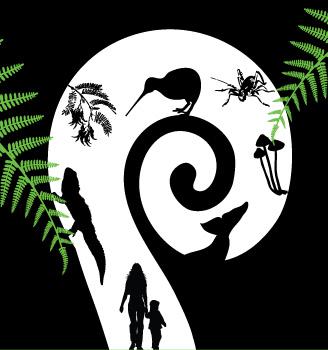
The 25th International Congress for Conservation Biology was held in Auckland, New Zealand, from the 5th to the 9th of December. I imagine I was probably the only ialeUK member to attend (having the advantage of currently being a local) but there was so much useful stuff that was of relevance to landscape ecology, that I thought I would endeavour to try and provide some sort of useful summary of what I discovered at the conference, and highlight some papers, websites, and software that might be of interest.
There were 7 sessions dedicated specifically to landscape ecology, plus another 11 sessions targeted at other relevant topics such as: biogeography, connectivity, corridors, reserve planning, spatial ecology, and habitat identification. In fact there were so many relevant sessions that I was unable to see everything that might be of interest to a landscape ecologist. So I’ll restrict my report to two general themes that are of particular interest to me (and hopefully others!) that I focused on during the conference: measuring connectivity and spatial planning.
Measuring Connectivity
Graph theory based techniques such as least-cost modelling and circuit theory are becoming commonly used in landscape ecology to measure connectivity and to map out potential movement corridors. For both techniques a resistance surface (otherwise known by combinations of: cost, friction, permeability, or resistance, and; layer, grid, map, raster, or surface) that describes how functional connectivity may vary across a landscape is the critical requirement.
With that in mind the president of the Society for Conservation Biology Paul Beier organised a session that looked at how to go about defining a resistance surface for graph theory based connectivity modelling such as least-cost modelling or circuit theory. The emphasis was that there is a need to shift from using expert opinion to define a resistance surface to using data based approaches instead. Stephen Spear gave an excellent overview of the problem presenting a recent paper of his (Spear et al. 2010). Some specific examples that came up during the session involved the use of radio-telemetry and landscape genetics (Cushman et al. 2006; Stevens et al. 2006; Chetkiewicz and Boyce 2009) to which I would add another that was presented at a landscape ecology session I organised at this years New Zealand Ecological Society annual conference (Richard and Armstrong 2010).
There was also a very interesting talk by Carlos Carroll who was presenting recently published work (Carroll et al. In Press) that compared graph theory centrality metrics that can be used to identify areas that are particularly important for connectivity across a landscape. Along with least-cost modelling and circuit theory, Carlos introduces another approach called network flow (think of water flowing through a network of different sized pipes). What may be of interest is that Carlos has developed a Connectivity Analysis Toolkit available freely online (www.connectivitytools.org) for undertaking these sorts of analyses.
Spatial Planning
Rafael Dias Loyola chaired an excellent session on spatial planning, from which there were four key points that seem to be recognised at important criteria for future work. Spatial planning is not a static problem, and that it needs to account for long-term changes and shorter-term disturbances in the landscape. Spatial planning cannot ignore uncertainties. Spatial planning cannot rely on simple targets. Socio-political consideration is imperative for successful implementation.
For those who are interested in spatial planning and reserve design, a couple of pieces of software were conspicuous by their presence at the conference. These were:
Marxan (http://www.uq.edu.au/marxan/) ;and
Zonation (http://www.helsinki.fi/bioscience/consplan/software/Zonation/index.html)
both of which may well be worth a look as they seemed to be quite popular.
I’ll also take the opportunity to put in a plug for an ongoing project that looks really interesting. Paul Beier is currently trying to figure out if corridors really do work, and is looking for “stable 50-year-old landscapes with patches and long, wide corridors” to assess if corridors are working by using landscape genetics. For those who are interested, or may have a suitable landscape, you may want to check out the website (http://www.docorridorswork.org/).
In summary, from my perspective and for my interests it was an excellent conference, and it was great to see landscape ecology playing such a central role in conservation biology around the world.
Biography
Tom has applied landscape ecology principles in a variety of settings from reserve design in Canada to management of wildlife diseases in the UK, and is now working on invasive species in New Zealand.
(email: teth001 [at] aucklanduni [dot] ac [dot] nz)
References
Carroll C, McRae BH & Brookes A (In Press) Use of Linkage Mapping and Centrality Analysis Across Habitat Gradients to Conserve Connectivity of Gray Wolf Populations in Western North America. Conservation Biology
Chetkiewicz CLB & Boyce MS (2009) Use of resource selection functions to identify conservation corridors. Journal of Applied Ecology 46:1036-1047
Cushman SA, McKelvey KS, Hayden J & Schwartz MK (2006) Gene flow in complex landscapes: testing multiple hypotheses with causal modeling. American Naturalist 168:486-499
Richard Y & Armstrong DP (2010) Cost distance modelling of landscape connectivity and gap-crossing ability using radio-tracking data. Journal of Applied Ecology 47:603-610
Spear SF, Balkenhol N, Fortin M-J, McRae BH & Scribner K. (2010) Use of resistance surfaces fro landscape genetic studies: considerations for parameterization and analysis. Molecular Ecology 19: 3576-3591.
Stevens VM, Verkenne C, Vandewoestijne S, Wesselingh RA & Baguette M (2006) Gene flow and functional connectivity in the natterjack toad. Molecular Ecology 15:2333-2344